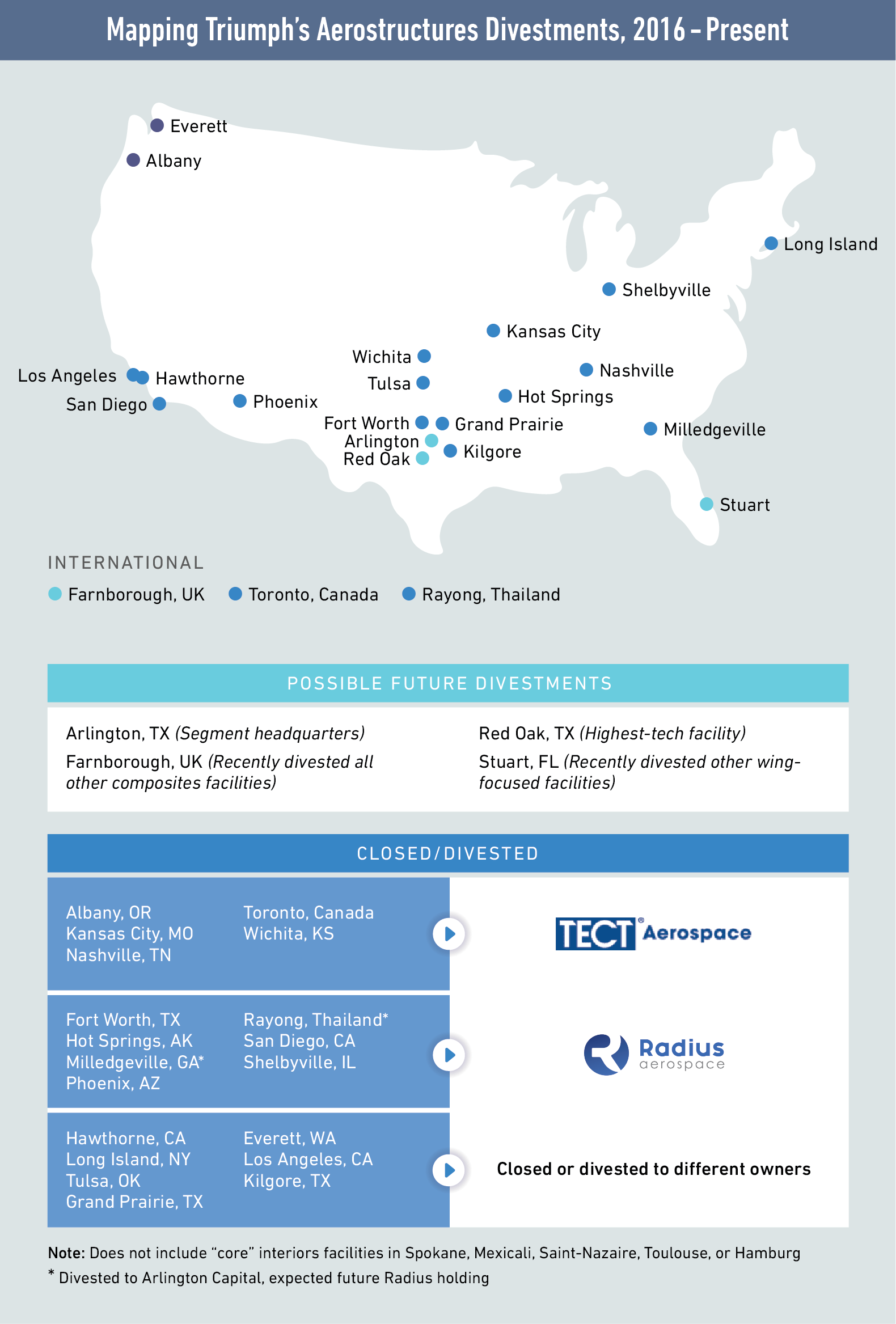The Challenge of Aerostructures: Lessons from Triumph

Following the appointment of CEO Daniel Crowley in 2016, Triumph Group announced its pursuit of a “One Triumph” strategy, focused in large part on divesting the Triumph aerostructures business.
Now, as the reorganization approaches the finish line, Triumph’s decision has remade a considerable chunk of the US aerostructures landscape and highlights the difficulty businesses face trying to integrate aerostructures with systems and MRO capabilities.
The Triumph experience suggests that more specialized aerostructures-only companies and vertically integrated aircraft OEMs may be better long-term stewards of the aerostructures market.
The History of Triumph Aerostructure’s Creation
Primarily a systems and aftermarket company from its founding in 1986, Triumph’s first major commitment to aerostructures manufacturing came in 2010 with the purchase of Vought Aircraft Industries from the Carlyle Group for $1.4 billion, vaulting the company firmly into the top echelon of aerospace suppliers.
While the acquisition equipped the company with the resources and scale to effectively build and service aircraft from nose to tail and deliver more integrated structures work packages—including profitable nacelles and accessory components—the debt needed to make the purchase and unfamiliar customer relationships with OEMs like Gulfstream made for challenging circumstances from the outset.
Lack of Growth With Triumph Aerostructure’s Division
Despite growth in the overall aerostructures market pre-Covid-19, with Boeing and Airbus ramping up production of jets across their product lines, Triumph aerostructures failed to benefit, with revenue stagnating under $3 billion annually from 2011 to 2016.
The company’s non-aerostructures products, meanwhile, experienced 38.9% compound annual growth during the same period, expanding from $290 million to $1.5 billion in annual revenue.[1]
Ultimately, Triumph reported a “kitchen sink quarter” and an aerostructures-driven loss of $1 billion during fiscal year 2016, driven by sunk development costs on the Bombardier 6000/7000 and Boeing’s 747-8 production rate slowdown.
A $152 million charge due to B747-8 contract issues was a final straw and marked the end of then-CEO Jeffry Frisby’s tenure at the company.
What is the One Triumph Strategy?
Under Crowley’s new One Triumph strategy, the company quickly began shedding aerostructures and streamlining its profitable assets, dramatically altering the makeup of its facilities in the continental US.
In May 2020, the company announced a summary of its “de-risking” actions, including “[the divestment of] its 10 build-to-print machine shops, five fabrication shops, two metal finishing facilities, and its two million square foot Nashville large structures plant…[and that] the transition of the Bombardier Global 7500 wing program, G-650 wing box assembly operation, and Embraer E2 fuselage contract have all been completed to their new owners.”[2]
The last vestiges of Triumph aerostructures’ activities are the facilities producing more profitable interiors components like insulation blankets and ducting, although their future under the Triumph banner is not necessarily guaranteed.

Of the Triumph aerostructures facilities that are no longer Triumph-branded, many are still robust manufacturing sites under new ownership, setting up somewhat of a Triumph legacy.
Arlington Capital Partners (ACP), an aerospace private equity firm, bought enough Triumph assets to form a new operating subsidiary, Radius Aerospace, with annual revenues of over $100 million.
ACP is also acquiring Triumph’s composites business, which will keep its existing management, technical and supporting staff, and operating locations.
TECT Aerospace, another private equity-backed entity, snatched up several other Triumph facilities, providing TECT with a strong initial foothold into wing components, a critical aerostructure in the airflow.
Lessons Learned from Triumph Aerostructures Divestment
The Triumph aerostructures investment and divestment saga offers several lessons for the industry. While some sites have shut down or are in the process of doing so, the continued operation of most former Triumph subsidiaries suggests there were few fundamental issues with these businesses.
Consolidation from private equity players like ACP offers evidence that scale still confers competitive advantages.
A broader lesson lies in the commitment and operational focus necessary to sustain aerostructures. The Triumph experience suggests it is difficult to do so while supporting non-structures businesses, especially those with more aftermarket exposure.
While Triumph has expertise in segments like interiors production and high-margin spare parts and repairs, aerostructures—with limited aftermarket potential and a need to relentlessly find manufacturing efficiencies—require a different skillset for success.
Instead, aerostructures are most likely to thrive under the watchful eye of highly optimized, standalone structures firms or parent OEMs like Gulfstream looking to bring production back in house.
In the coming post-Covid-19 supply chain shake up, OEMs will likely select aerostructures partners who have streamlined their operations, offer cost-effective solutions, and remain reliable, high quality suppliers—areas in which the reimagined Triumph aerostructures groups may hold a competitive edge.
Fundamentally, companies interested in sustaining competitiveness in both the aerostructures and aircraft systems ecosystems should take heed from Triumph’s less-than-ideal attempt to create a “Tier One Capable” supplier, understanding that a strong balance sheet and careful evaluation of the operating intricacies across supply chain segments are necessary building blocks for long-term success.
Subscribe to the Avascent Altimeter
We invite you to subscribe to the Avascent Altimeter – Insights delivered to your inbox on critical issues shaping the Commercial Aerospace industry’s future.




